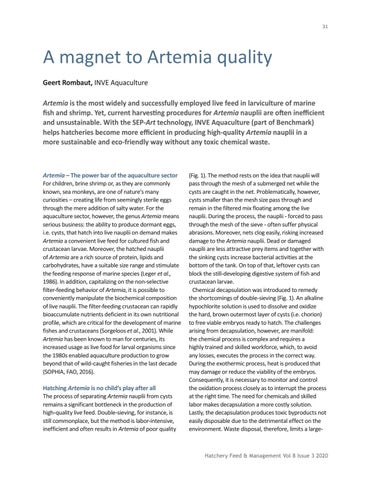31
A magnet to Artemia quality Geert Rombaut, INVE Aquaculture Artemia is the most widely and successfully employed live feed in larviculture of marine fish and shrimp. Yet, current harvesting procedures for Artemia nauplii are often inefficient and unsustainable. With the SEP-Art technology, INVE Aquaculture (part of Benchmark) helps hatcheries become more efficient in producing high-quality Artemia nauplii in a more sustainable and eco-friendly way without any toxic chemical waste.
Artemia – The power bar of the aquaculture sector For children, brine shrimp or, as they are commonly known, sea monkeys, are one of nature’s many curiosities – creating life from seemingly sterile eggs through the mere addition of salty water. For the aquaculture sector, however, the genus Artemia means serious business: the ability to produce dormant eggs, i.e. cysts, that hatch into live nauplii on demand makes Artemia a convenient live feed for cultured fish and crustacean larvae. Moreover, the hatched nauplii of Artemia are a rich source of protein, lipids and carbohydrates, have a suitable size range and stimulate the feeding response of marine species (Leger et al., 1986). In addition, capitalizing on the non-selective filter-feeding behavior of Artemia, it is possible to conveniently manipulate the biochemical composition of live nauplii. The filter-feeding crustacean can rapidly bioaccumulate nutrients deficient in its own nutritional profile, which are critical for the development of marine fishes and crustaceans (Sorgeloos et al., 2001). While Artemia has been known to man for centuries, its increased usage as live food for larval organisms since the 1980s enabled aquaculture production to grow beyond that of wild-caught fisheries in the last decade (SOPHIA, FAO, 2016). Hatching Artemia is no child’s play after all The process of separating Artemia nauplii from cysts remains a significant bottleneck in the production of high-quality live feed. Double-sieving, for instance, is still commonplace, but the method is labor-intensive, inefficient and often results in Artemia of poor quality
(Fig. 1). The method rests on the idea that nauplii will pass through the mesh of a submerged net while the cysts are caught in the net. Problematically, however, cysts smaller than the mesh size pass through and remain in the filtered mix floating among the live nauplii. During the process, the nauplii - forced to pass through the mesh of the sieve - often suffer physical abrasions. Moreover, nets clog easily, risking increased damage to the Artemia nauplii. Dead or damaged nauplii are less attractive prey items and together with the sinking cysts increase bacterial activities at the bottom of the tank. On top of that, leftover cysts can block the still-developing digestive system of fish and crustacean larvae. Chemical decapsulation was introduced to remedy the shortcomings of double-sieving (Fig. 1). An alkaline hypochlorite solution is used to dissolve and oxidize the hard, brown outermost layer of cysts (i.e. chorion) to free viable embryos ready to hatch. The challenges arising from decapsulation, however, are manifold: the chemical process is complex and requires a highly trained and skilled workforce, which, to avoid any losses, executes the process in the correct way. During the exothermic process, heat is produced that may damage or reduce the viability of the embryos. Consequently, it is necessary to monitor and control the oxidation process closely as to interrupt the process at the right time. The need for chemicals and skilled labor makes decapsulation a more costly solution. Lastly, the decapsulation produces toxic byproducts not easily disposable due to the detrimental effect on the environment. Waste disposal, therefore, limits a large-
Hatchery Feed & Management Vol 8 Issue 3 2020
